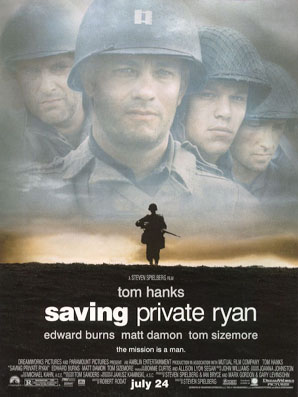Spielberg has done it again. He revisits his familiar stomping grounds of World War II to deliver his latest masterpiece. This time, he tackles the war itself, delivering a vivid portrait of modern warfare from the common soldier’s point of view.
Set during the invasion of Normandy, and in the days which follow, Saving Private Ryan tracks the mission of the 2nd Ranger Battalion of the 29th Infantry Division. Led by Captain John Miller (Tom Hanks), seven of his surviving men are given an unusual mission: to locate a soldier, missing behind enemy lines, and send him home.
Within days, three brothers of the Ryan family were all killed in combat, and a fourth, Private James Ryan, has gone missing somewhere around Normandy. To ease the suffering of the boys’ mother (and to avoid a public relations fiasco), the top brass want Private Ryan found and sent home.
In the squad sent to find him, there is trusty Sergeant Horvath (Tom Sizemore), who lends a needed ear to the captain, and keeps the men in line. Pvt. Reiben (Edward Burns) is the chief griper of the group. Pvt. Caparzo (Vin Diesel) also has doubts. Sharpshooter Pvt. Jackson (Barry Pepper) places his faith in God and his gun. Pvt. Mellish (Adam Goldberg) is a Jewish soldier who has a personal stake in the war. Wade (Giovanni Ribisi) is a medic, frustrated by the hopelessness of his task during wartime. Rounding out the group is Cpl. Upham (Jeremy Davies), a meek mapmaker who’s never seen combat, but speaks fluent French and German.
A lot has been said of the violence in the film. While not the goriest film around, people expecting a traditional Steven Spielberg or Tom Hanks film should prepare themselves for the extremely graphic scenes. Unlike most movie violence, the violence here comes coupled with considerable emotional impact. This is the most intense modern war movie ever made…every casualty onscreen truly feels like an actual life, and the impact is staggering.
The extended battle sequences are some of the most powerful moments ever put on film. From the very start, you can barely breathe as the action unfolds on the screen. Using discomforting handheld shots, various film speeds, and ample use of surround sound, the result is terrifyingly realistic.
The story of Saving Private Ryan has been very well structured. It begins by delivering grief at a personal level: that of Mrs. Ryan, confronted with the loss of three of her sons (and the possible loss of her fourth). However, from that initial shock, the audience is able to grasp the emotional impact of any and every soldier losing his life. The results are staggering.
The film raises no judgments about the war itself. These aren’t men disillusioned in the cause, but they are frustrated in that they are placed in jeopardy for what seems like a purely public-relations stunt. All they really want it to help quickly end the war and get home. Why should Pvt. Ryan be the lucky one…all of these men have mothers and loved ones who would grieve for them?
Tom Hanks delivers a strong performance, which, while not his best, is certainly among them. He has to rationalize the potential and actual loss of every man under his command, and to keep himself from cracking under the considerable pressure. Hanks’ everyman persona helps to draw in the audience with a sense of familiarity amid the chaos.
There are a few cameos placed here and there (Matt Damon pops up as a soldier encountered by the squad), but most of the actors in the film are portrayed by relative unknowns. This actually works out well, adding an element of uncertainty (particularly in the early scenes, when you’re truly unsure of who is going to survive that first reel). However, the entire squad gives memorable performances, and it is difficult to single one or two actors out above the others. Tom Sizemore is debatedly the best of the bunch, but it is a close call.
It would be difficult to say that this is Spielberg’s best film (considering his remarkable filmography). But it is certainly among his best…and one of the best films of this decade.


